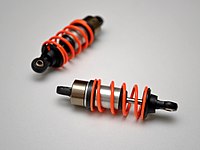
Photo from wikipedia
Friction pendulum systems (FPSs) are a common solution for isolating civil engineering structures under ground movements. The result is a base-isolated structure in which the base exhibits low shear stiffness… Click to show full abstract
Friction pendulum systems (FPSs) are a common solution for isolating civil engineering structures under ground movements. The result is a base-isolated structure in which the base exhibits low shear stiffness in such a way that the input energy of the earthquake is concentrated and dissipated into it, leaving the superstructure free of damage. As a consequence, large displacements of the FPS may be demanded depending on the earthquake intensity and the fundamental period of the FPS. To accommodate these displacements, large-size isolators with high friction coefficients are usually required. However, the FPS will then exhibit poor re-centering capacity and the risk of future shocks will increase due to previous residual displacements, especially for low-intensity earthquakes. An alternative solution is to include a semi-active damper to the FPS, keeping the friction coefficient low and achieving both, limited base displacement under high-intensity earthquakes and good re-centering capacity under low-intensity ones. Thus, this work presents a design methodology for base isolators formed by an FPS with a damper added. The design methodology is applied to an FPS with a passive damper and to an FPS with a semi-active damper. Two ON-OFF control strategies are studied: (i) a fairly simple phase control, and (ii), a mechanical energy-predictive based algorithm. The advantages of semi-active FPSs with low friction coefficients with respect to FPS with high friction coefficients are demonstrated. The results with the designed semi-active FPS are compared with the single FPS and the FPS with a passive damper. Finally, the use of semi-active FPS allows us to enhance the FPS performance as the isolator size can be reduced while keeping the capacity to cope with low and high-intensity earthquakes without residual displacements.
Journal Title: Applied Sciences
Year Published: 2020
Link to full text (if available)
Share on Social Media: Sign Up to like & get
recommendations!